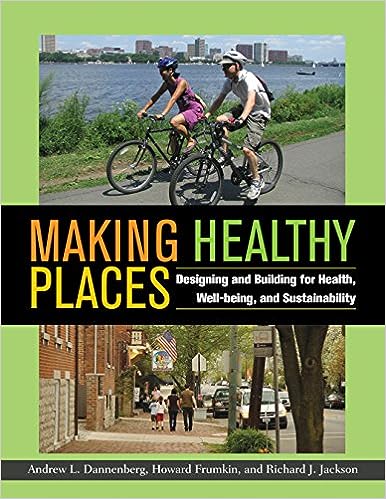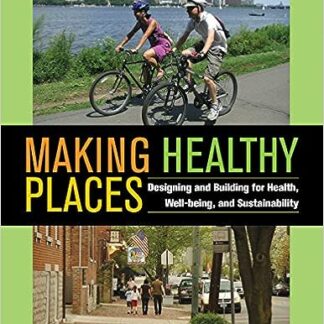Description
The environment that we construct affects both humans and our natural world in myriad ways. There is a pressing need to create healthy places and to reduce the health threats inherent in places already built. However, there has been little awareness of the adverse effects of what we have constructed-or the positive benefits of well designed built environments. This book provides a far-reaching follow-up to the pathbreaking Urban Sprawl and Public Health, published in 2004. That book sparked a range of inquiries into the connections between constructed environments, particularly cities and suburbs, and the health of residents, especially humans. Since then, numerous studies have extended and refined the book’s research and reporting. Making Healthy Places offers a fresh and comprehensive look at this vital subject today. There is no other book with the depth, breadth, vision, and accessibility that this book offers. In addition to being of particular interest to undergraduate and graduate students in public health and urban planning, it will be essential reading for public health officials, planners, architects, landscape architects, environmentalists, and all those who care about the design of their communities. Like a well-trained doctor, Making Healthy Places presents a diagnosis of–and offers treatment for–problems related to the built environment. Drawing on the latest scientific evidence, with contributions from experts in a range of fields, it imparts a wealth of practical information, with an emphasis on demonstrated and promising solutions to commonly occurring problems. Read more
Review “It is just about the most authoritative and thorough examination of how our urban design (and house design) affects our health and wellbeing, and should be on the desk of every urban designer and planner as an important reference… I cannot imagine writing about urban issues involving food, health, safety or transportation without picking this up for a quote or a reference; it is going to be an essential tool.” ― Treehugger”This comprehensive, beautifully edited volume explains why and how our physical environment profoundly affects each of us, our family, our community, and our nation. A treasure of excellent chapters by well-respected experts, it is replete with practical wisdom on how to diagnose and ameliorate the wide range of environmental problems, with inspiring examples of success. Reading it is the equivalent of a top tier graduate level course in practical environmental health.” — Jonathan Fielding ― M.D., M.P.H., Professor of Health Services and Pediatrics, UCLA and Director of Public Health”The authors have crafted an exemplary look at the various components of community design that promote and support health. Through their perspective we see clearly how much community design matters to our health and well-being; and it matters a lot.” — Georges C. Benjamin ― M.D., Executive Director, American Public Health Association”The editors of this powerful volume put design squarely in the public health armamentarium. Both a guide and call to action, its well-researched chapters provide a foundation for profound change in design practice and education. The truly beautiful stairway is one that beckons us to use it—the same applies to sidewalks, parks, bike lanes, playgrounds, and public transportation.” — Daniel S. Friedman ― PhD, FAIA, Dean, College of Built Environments, University of Washington”Here’s a book that mayors, health officials, developers, architects, planners and environmentalists will want to read and keep handy. Dannenberg, Frumkin, and Jackson call for big gains in public health, environmental and economic performance and provide the necessary advice to achieve such a transformation.” — John Norquist ― President of the Congress for the New Urbanism and former Mayor of Milwaukee, WI”Dannenberg … et al. …outline the major health issues that relate to the built environment, including physical activity, food, air and water quality, injury, mental health, and social bonds, and specific transportation and land use aspects. They also address how to create change, the future training of professionals, research, and urban health in low and middle-income countries.” ― Reference & Research Book News”The book is an extensive, sometimes exhausting, overview of many related topics. The challenges it presents are sobering. The solutions it envisions are exciting. Landscape architecture is present throughout. Some may find it a “heavy lift” given its length and, in some instances, highly technical nature. But it is all there, providing landscape architects, architects, and planners with tools and strategies to think about how the built environment impacts our physical, mental, social, environmental, and economic well-being.” ― ASLA’s The Dirt blog”The book’s introduction states it is primarily aimed at students but it would disappointing if this timely research fails to reach other audiences—in particular politicians at all levels of government.” ― Spacing”The editors seek to avoid technical jargon that might put off the students to whom the book is addressed.” ― American Planning Association”The thesis is simple. The urban environment should be planned and built to encourage physical exercise, a healthy diet, low pollution levels, accessible nature necounters, and mental serenity.” ― CHOICE”This book explores how the built environment continues to impact on health (and consequently life chances) and sets out how planners, policy makers, designers and educators can influence this dynamic and engage with the ‘perfect storm of intersecting health, environmental, and economic challenges’.” ― Urban Journal”Making Healthy Places, although it is not a theological work, is deeply theological in the vision of health that is seeking and is a book that not only must be read and discussed in churches, we must also allow it to shape our vision of what the mission of the church is in our particular places, and as such it is one of the most significant books that I’ve read this year!” ― Englewood Review of Books Book Description Making Healthy Places presents a diagnosis of-and offers treatment for-problems related to the built environment. About the Author Andrew L. Dannenberg, MD, MPH, is an affiliate professor in the Department of Environmental and Occupational Health Sciences and in the Department of Urban Design and Planning at the University of Washington in Seattle, where he teaches courses on healthy community design and on health impact assessment. For the past decade, his research and teaching have focused on examining the health aspects of planning and designing our built environment, including land use and transportation. He has a particular interest in the use of a health impact assessment as a tool to inform community planners about the health consequences of their decisions. He previously served as the team leader of the Healthy Community Design Initiative at the Centers for Disease Control and Prevention’s (CDC) National Center for Environmental Health in Atlanta. In earlier work, Dr. Dannenberg served as director of the Division of Applied Public Health Training at the CDC, as the preventive medicine residency director and injury prevention epidemiologist on the faculty at the Johns Hopkins University School of Public Health in Baltimore, and as a cardiovascular epidemiologist at the National Institutes of Health in Bethesda. He received an MD from Stanford University and an MPH from Johns Hopkins University, and completed a family medicine residency at the Medical University of South Carolina. He is co-editor of Making Healthy Places: Designing and Building for Health, Well-being, and Sustainability with Howard Frumkin and Richard J. Jackson.Howard Frumkin, MD, DrPH is Senior Vice President of the Trust for Public Land, and professor emeritus of Environmental and Occupational Health Sciences at the University of Washington School of Public Health, where he was Dean from 2010-2016. He was previously head of Our Planet, Our Health at the Wellcome Trust, director of the National Center for Environmental Health and Agency for Toxic Substances and Disease Registry (NCEH/ATSDR), and Special Assistant to the CDC Director for Climate Change and Health, and Professor and Chair of Environmental and Occupational Health at Emory University’s Rollins School of Public Health and Professor of Medicine at Emory Medical School. Dr. Frumkin has served on the Boards of the Bullitt Foundation, the Seattle Parks Foundation, the American Public Health Association, the US Green Building Council, the Children and Nature Network, and Physicians for Social Responsibility, among others. He has served on the Steering Committee of the Planetary Health Alliance (Harvard University), as a faculty affiliate at UCLA’s Center for Healthy Climate Solutions, and on advisory committees to the Global Consortium on Climate and Health Education (Columbia University), the Medical Society Consortium on Climate & Health (George Mason University), EcoHealth International, and the Yale Center on Climate Change and Health. He is the author, co-author, or editor of over 300 scientific journal articles, chapters, and books, including the standard environmental health textbook, Environmental Health: From Global to Local, and four Island Press titles. Dr. Frumkin is a Fellow of the American College of Physicians, the American College of Occupational and Environmental Medicine, Collegium Ramazzini, and the Royal College of Physicians of Ireland, and an elected member of the Washington State Academy of Sciences and the National Academy of Medicine. He loves cycling, kayaking, and hiking. He is married to radio journalist Joanne Silberner, and has two children. Richard J. Jackson, MD, MPH, is Professor and Chair of Environmental Health Sciences at the School of Public Health at the University of California, Los Angeles. He is also a faculty member in the departments of Pediatrics, Urban Planning, and the Institute of the Environment and Sustainability at UCLA. A pediatrician and public health leader, he has served as State Health Officer for California and in many other leadership positions in both the environmental health and infectious disease fields. For nine years he was director of the Centers for Disease Control and Prevention’s (CDC) National Center for Environmental Health in Atlanta, for which he received the Presidential Distinguished Service award. While in California he helped establish the California Birth Defects Monitoring Program and state and national laws to reduce risks from dangerous pesticides, especially to farm workers and children. While at the CDC, he established the national asthma epidemiology and control program, oversaw the Childhood Lead Poisoning Prevention Program, and instituted the current federal effort to “biomonitor” chemical levels in the U.S. population. In the late 1990s he was the CDC leader in establishing the U.S. National Pharmaceutical Stockpile to prepare for terrorism and other disasters (the stockpile was activated on September 11, 2001). He has received the Breast Cancer Fund’s Hero Award, as well as Lifetime Achievement Awards from the Public Health Law Association and New Partners for Smart Growth. He received an MD from the University of California at San Francisco and an MPH from the University of California at Berkeley. Dr. Jackson lectures and speaks on many issues, particularly those related to the built environment and health. He has co-authored two Island Press Books: Urban Sprawl and Public Health and, more recently, Making Healthy Places: Designing and Building for Health, Well-Being, and Sustainability with Andrew L. Dannenberg and Howard Frumkin. He is the narrator of a 2011 PBS special Designing Healthy Communities. He has served on many environmental and health boards, as well as the Board of Directors of the American Institute of Architects.Timothy Beatley is the Teresa Heinz Professor of Sustainable Communities at the School of Architecture at the University of Virginia, where he has taught for over twenty-five years. His primary teaching and research interests are in environmental planning and policy, with a special emphasis on coastal and natural hazards planning, environmental values and ethics, and biodiversity conservation. He has published extensively in these areas, including the following books: Ethical Land Use; Habitat Conservation Planning: Endangered Species and Urban Growth; Natural Hazard Mitigation; and An Introduction to Coastal Zone Management. In recent years much of his research and writing has been focused on the subject of sustainable communities and creative strategies by which cities and towns can reduce their ecological footprints, while at the same time becoming more livable and equitable places. His books that explore these issues include Biophilic Cities, Resilient Cities, and Blue Urbanism (Island Press). Excerpt. © Reprinted by permission. All rights reserved. Making Healthy PlacesDesigning and Building for Health, Well-being, and SustainabilityBy Andrew L. Dannenberg, Howard Frumkin, Richard J. JacksonISLAND PRESSCopyright © 2011 Andrew L. Dannenberg, Howard Frumkin, and Richard J. JacksonAll rights reserved.ISBN: 978-1-59726-727-4ContentsPreface Richard J. Jackson, Part I. Introduction, Chapter 1 An Introduction to Healthy Places Howard Frumkin, Arthur M. Wendel, Robin FranAbrams, and Emil Malizia, Part II. The Impact of Community Design on Health, Chapter 2 Community Design for Physical Activity James F. Sallis, Rachel A. Millstein, and Jordan A. Carlson, Chapter 3 Food Environments Carolyn Cannuscio and Karen Glanz, Chapter 4 Community Design and Air Quality Jonathan M. Samet, Chapter 5 Injuries and the Built Environment David A. Sleet, Rebecca B. Naumann, and Rose Anne Rudd, Chapter 6 Community Design for Water Quantity and Quality Lorraine C. Backer, Chapter 7 Mental Health and the Built Environment William C. Sullivan and Chun-Yen Chang, Chapter 8 Social Capital and Community Design Caitlin Eicher and Ichiro Kawachi, Chapter 9 Vulnerable Populations and the Built Environment Chris S. Kochtitzky, Part III. Diagnosing and Healing Our Built Environments, Chapter 10 Transportation and Land Use Reid Ewing, Gail Meakins, Grace Bjarnson, and Holly Hilton, Chapter 11 Healthy Homes James Krieger and David E. Jacobs, Chapter 12 Healthy Workplaces Donna S. Heidel, L. Casey Chosewood, Matthew Gillen, Paul Schulte, Gregory Wagner, Kenneth M. Wallingford, and Liz York, Chapter 13 Healthy Health Care Settings Craig Zimring and Jennifer DuBose, Chapter 14 Healthy Schools Howard Frumkin and Jared Fox, Chapter 15 Contact with Nature Howard Frumkin and Jared Fox, Chapter 16 Resiliency to Disasters Timothy Beatley, Part IV. Strategies for Healthy Places: A Toolbox, Chapter 17 Behavioral Choices and the Built Environment Margaret Schneider, Chapter 18 Policy and Legislation for Healthy Places Lisa M. Feldstein, Chapter 19 Community Engagement in Design and Planning Manal J. Aboelata, Leah Ersoylu, and Larry Cohen, Chapter 20 Measuring, Assessing, and Certifying Healthy Places Andrew L. Dannenberg and Arthur M. Wendel, Part V. Looking Outward, Looking Ahead, Chapter 21 Training the Next Generation to Promote Healthy Places Nisha D. Botchwey and Matthew J. Trowbridge, Chapter 22 Healthy Places Research: Emerging Opportunities Richard J. Jackson, Arthur M. Wendel, and Andrew L. Dannenberg, Chapter 23 Urban Health in Low- and Middle-Income Countries Jennifer C. Johnson and Sandro Galea, Chapter 24 Built Environments of the Future Anthony G. Capon and Susan M. Thompson, Glossary, About the Editors, Contributors, Acknowledgments, Index, CHAPTER 1An Introduction to Healthy PlacesHoward Frumkin, Arthur M. Wendel, Robin Fran Abrams, and Emil MaliziaKey Points• The environment consists of the external (or nongenetic) factors—physical, nutritional, social, behavioral, and others—that act on humans, and the built environment is made up of the many aspects of their surroundings created by humans, such as buildings, neighborhoods, and cities.• Health can be defined as complete physical, mental, and social well-being. This definition extends beyond the absence of disease to include many dimensions of comfort and well-being. While clinicians care for individual patients, public health professionals aim to improve health at the level of populations.• The design professions include urban planning, architecture, landscape architecture, and transportation planning. Each of these focuses on an aspect of the built environment.• Both the public health profession and the design professions took modern form during the nineteenth century, in response to rapid population growth, industrialization and urbanization, and the resulting problems of the urban environment.• Public health practice is evidence-based, relying heavily on surveillance and data collection.• Leading causes of morbidity and mortality include heart disease, cancer, diabetes, stroke, injuries, and mental illness. Many of these are related to community design choices.• Even though public health has evolved as a distinct field from planning and architecture, these domains have numerous opportunities to collaborate, and this collaboration can lead to improved health, well-being, and sustainability in many ways.IntroductionThe citizens of Bay City were fed up. Getting across town to go to work or shopping had become an ordeal; the streets seemed perpetually clogged, and it was impossible to find parking. For people who had bought homes in the suburbs, life seemed to take place more and more in their cars—chauffeuring children to school and soccer games, driving long distances to stores, and worst of all, commuting to work. Meanwhile, the Bay City Courier reported a steady drumbeat of bad news: air quality was worsening, the health department reported a growing epidemic of obesity, and nearly every day there was a tragic car crash that killed or injured somebody.The mayor, the city council, and the transportation department teamed up to address some of the quality of life problems. They envisioned an ambitious program of road building. Key components included a six-lane arterial highway along the bay shore, two new arterials crossing the city, and thousands of new parking spaces. Although this plan would destroy historic and beautiful bay views, sever a few older neighborhoods, and remove half of a prized city park, it would move traffic more effectively.But the roads were never built. The local health department, urban planners, architects, physicians and nurses, park officials, historic preservationists, environmentalists, and neighborhood associations all came together in a remarkable display of unity. The coalition they formed proposed an alternative plan, one that centered on extensive pedestrian and bicycle infrastructure, investments in bus and light-rail transit, mixed-use development along the bay shore, and investments in parks throughout the city. The plan emphasized equity and included policies to avoid displacing established communities and to ensure a mix of housing types. The cost of this alternative plan would be slightly less than that of the combined road projects, and it would create a similar number of construction jobs.The alternative plan won the day. It took more than twenty years to implement, and it required considerable political leadership to stick with it during the inevitable cost overruns and budget crises. But after twenty years, a remarkable series of changes had ensued.The proportion of people walking or biking to work had risen from 3 percent to 14 percent, and the proportion of students walking or biking to school had risen from 5 percent to 21 percent. Transit ridership had increased more than fourfold. Traffic volume had actually decreased, air quality had improved marginally, and the epidemic of obesity had stabilized and was showing signs of reversing. Because many young families had moved into the city, the public schools had improved considerably and were now among the best in the state. And Bay City had become a destination city, attracting several prized high-tech and biotech firms because of its well-recognized commitment to environmental sustainability, health, and quality of life.This is a book about healthy places—places in which people can grow up, live, work, play, study, pray, and age in ways that allow them to be safe and healthy, to thrive, and to reach their full potential.A healthy place can be very small, such as an ergonomically designed chair that reduces strain on the back, shoulders, and arms. A healthy place can be immense, such as a planet with a relatively stable climate that allows ecosystems, forests, waterways, and farms to remain balanced and productive, which in turn allows humans to pursue their lives in relative safety, security, and predictability. The healthy places we explore in this book are intermediate in scale, ranging from buildings to metropolitan areas. Nearly all of these places are designed and created by people. In this introduction we define some basic concepts in environment, health, planning, and design. We note that these are human enterprises with a long history—that our forebears have been working toward healthy places since before the dawn of written history and that the modern health and design professions took shape during the transformative events of the last two centuries.In Merriam-Webster’s Collegiate Dictionary, the first definition for environment is straightforward: “the circumstances, objects, or conditions by which one is surrounded.” The second definition is more intriguing: “the complex of physical, chemical, and biotic factors (as climate, soil, and living things) that act upon an organism or an ecological community and ultimately determine its form and survival.” From a human health perspective, the environment includes all the external (or nongenetic) factors—physical, nutritional, social, behavioral, and others—that act on humans. The built environment consists of those settings designed, created, and maintained by human efforts—buildings, neighborhoods, public plazas, playgrounds, roadways, and more. Even seemingly natural settings, such as parks, are often part of the built environment because they have been sited, designed, and constructed by people. The built environment depends on supporting infrastructure systems for such necessities as energy, water, and transportation, so these systems are also considered part of the built environment.A widely accepted definition of health comes from the 1948 constitution of the World Health Organization (WHO 2003): “A state of complete physical, mental, and social well-being and not merely the absence of disease or infirmity.” This broad definition goes well beyond a narrowly biomedical view to include many dimensions of comfort and well-being.Many health professions exist. Some are clinical and focus on providing health care (and preventive services) to individuals; examples include medicine, nursing, dentistry, physical therapy, and occupational therapy. Other health professions operate at the community level, focusing on populations more than on individuals. These professions collectively make up the public health field. Public health is dedicated to fulfilling society’s interest in assuring conditions in which people can be healthy, conditions that range from effective health care systems to healthy environments. Public health professionals pursue this mission by assessing and monitoring community health to identify problems, developing public policies to solve these problems, and working to ensure access to appropriate and cost-effective care, including preventive care. These functions have been codified as the “ten essential services of public health” (Figure 1.1), a common framework for health departments and other service providers (CDC, National Public Health Performance Standards Program 2010).Environmental health, a subfield of public health, focuses on the relationships between people and their environments. It aims to promote healthy environments and to control environmental hazards. Traditional environmental health focused on sanitation issues, such as clean water, sewage, waste management, food safety, and rodent control. In recent decades, environmental health has expanded its scope to address chemical and radiological hazards, such as pesticides and air pollution. And most recently, environmental health has addressed cross-cutting issues, including the built environment, climate change, and sustainability—topics that are addressed in this book.The design professions are those that focus on how things are made. There are many design professions, ranging from industrial design (consumer products) to graphic design (visual images). In this book we focus on several design professions whose work relates to the built environment. Each has specific training pathways, professional organizations, and areas of specialization (Table 1.1).Urban planning (also known as town planning, city planning, or city and regional planning) is dedicated to envisioning, planning, designing, and monitoring the layout and function of cities. Transportation planning (along with the closely related field of transportation engineering) focuses on transportation infrastructure—not only streets and highways but also mass transit and the infrastructure for nonmotorized travel, such as sidewalks and bike paths.Architecture is the design profession that operates at the scale of buildings. Architects may specialize in a certain class of buildings, such as commercial or residential structures or, even more specifically, hospitals or laboratories. Many architects now incorporate green building principles, such as energy conservation and the use of renewable resources.Figure 1.1 Public health professionals focus on providing ten essential public health services designed to maintain and improve health in communities (CDC, National Public Health Performance Standards Program 2010).Civil engineering is the field of engineering focused on the design, construction, and maintenance of built environment elements such as bridges, roads, canals, and dams. A related field, environmental engineering, emphasizes environmental performance. Civil and environmental engineers might collaborate in designing storm water systems and working to prevent erosion, conserve water, and reduce contamination of rivers and streams—all goals that directly or indirectly promote human health.Landscape architecture focuses on the arrangement of natural and built elements on the land, from the design of parks to plans for large-scale watershed management.All of these professions are related. The health professions, in promoting health, may consider features of the built environment such as land use or transportation strategies. The design professions may identify health as a key goal of their work. In this book we explore why and how these professions need to come together to achieve safe, healthy settings for all people.Health and the Built Environment: Ancient OriginsDesigning and building safe and healthy places must have been a goal for our earliest ancestors (even if they did not put it in quite those terms). The elements can be harsh, and we know that our forebears sought protection in caves or built crude shelters.The greatest of ancient civilizations were built according to careful and complex plans, from the scale of buildings to the scale of vast cities. In ancient city remains across the world, there is evidence of gridlike, hierarchical street arrangements, of monuments and public spaces, of terraces carefully built to manage water flow, and of sophisticated building designs. Many of these achievements reflected efforts to protect health.Modern health challenges in the built environment often have ancient origins. In the ruins of past civilizations from India to Rome and from Greece to Egypt to South America, archaeologists have found the remains of water pipes, toilets, and sewage lines, some dating back more than 4,000 years (Rosen [1958] 1993). Indoor air quality has been a long-standing challenge; there is evidence in the sinus cavities of ancient cave dwellers of high levels of smoke in their caves (Brimblecombe 1988). Mold was apparently a scourge in some ancient buildings, described in vivid detail in the Old Testament as a greenish or reddish “plague” on walls (Leviticus 14:33–45). European history was changed forever when rats spread the Black Death in fourteenth-century cities (Cantor 2001; Kelly 2005). Modern cities continue to struggle periodically with infestations of rats and other pests (Sullivan 2004), whose control depends in large part on modifications to the built environment.Birth of Modern Public HealthModern public health took form largely during the age of industrialization, with the rapid growth of cities in the seventeenth and eighteenth centuries. “The urban environment,” wrote one historian, “fostered the spread of diseases with crowded, dark, unventilated housing; unpaved streets mired in horse manure and littered with refuse; inadequate or non-existing water supplies; privy vaults unemptied from one year to the next; stagnant pools of water; ill-functioning open sewers; stench beyond the twentieth-century imagination; and noises from clacking horse hooves, wooden wagon wheels, street railways, and unmuffled industrial machinery” (Leavitt 1982, 22). Epidemics of cholera, typhoid, yellow fever, and diphtheria occurred with regularity. Social reformers, scientists and engineers, physicians, and public officials responded to these conditions in various ways across the industrializing nations (for full historical accounts see Rosen [1958] 1993; Duffy 1990; Tarr 1996; Melosi 2000).Many interventions by early public health leaders focused on the built environment. For example, regular outbreaks of cholera and other diarrheal diseases in the eighteenth and nineteenth centuries (Rosenberg 1962) highlighted the need for water systems with clean source water, treatment including filtration, and distribution through pipes. Similarly, sewage management became a necessity, especially after the provision of piped water and the use of toilets created large volumes of contaminated liquid waste (Duffy 1990; Melosi 2000). (Continues…)Excerpted from Making Healthy Places by Andrew L. Dannenberg, Howard Frumkin, Richard J. Jackson. Copyright © 2011 Andrew L. Dannenberg, Howard Frumkin, and Richard J. Jackson. Excerpted by permission of ISLAND PRESS. All rights reserved. No part of this excerpt may be reproduced or reprinted without permission in writing from the publisher.Excerpts are provided by Dial-A-Book Inc. solely for the personal use of visitors to this web site. Read more
Refund and Returns Policy
Due to the nature of digital products, pdfTextbook does not offer refunds or returns for this product and all sales are final. please contact our customer service team before your purchase at [email protected].





Reviews
There are no reviews yet.